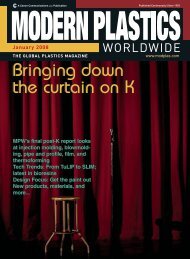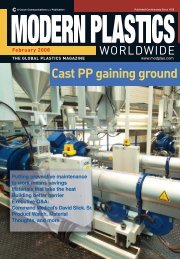Modern Plastics Worldwide - July/August 2009 - dae uptlax
Modern Plastics Worldwide - July/August 2009 - dae uptlax
Modern Plastics Worldwide - July/August 2009 - dae uptlax
Create successful ePaper yourself
Turn your PDF publications into a flip-book with our unique Google optimized e-Paper software.
PROCESSING<br />
TECHNOLOGY<br />
Let the processing begin<br />
How are parts formed? First the<br />
pre-cut decorative material is<br />
placed in the second cavity of the<br />
open mold and fixed in place. The<br />
mold closes and the decorative<br />
material is preformed, while in the<br />
first cavity the polypropylene (PP)<br />
is molded and then cooled. When<br />
the mold opens, the PP supporting<br />
structure remains in the moving<br />
mold half and the pre-formed<br />
decorative material remains in the<br />
stationary mold half.<br />
The two halves of the open<br />
mold are then repositioned by<br />
means of a sliding table so that the<br />
PP supporting structure and the<br />
preformed decorative material face<br />
each other. The mold then closes but a<br />
gap remains between the halves. This<br />
gap represents the thickness of the foam<br />
layer and is determined by the geometry<br />
of the second cavity; it is deeper than<br />
the geometry of the first cavity by a<br />
distance equal to the desired thickness<br />
of the foam.<br />
This gap is then filled with foam,<br />
with either expandable TPE injected into<br />
the gap via a gating system and diverter<br />
mpw.plasticstoday.com<br />
PROCESSING TRENDS<br />
Here, shown in a 2-injection unit configuration, the<br />
Varysoft slide-table mold lets processors get softtouch<br />
foam exactly where it is needed.<br />
mounted on top of the mold, or via the<br />
PUR mixing head, docked against the<br />
underside of the mold. Once foaming is<br />
complete, parts can be de-molded and<br />
any surplus decorative material can be<br />
trimmed.<br />
In another decorative development,<br />
Kaufmann also says it can make injection<br />
molds suitable for back injection<br />
molding of metal films. Such films could<br />
be thick enough to give the feel and<br />
look of a genuine metal surface,<br />
more so than with electroplating,<br />
but without requiring a secondary<br />
operation.<br />
Here again, the process is deceptively<br />
simple. The metal film is<br />
placed and held in a mold in essentially<br />
the same way as any other<br />
decorative surface would be for<br />
back injection molding.<br />
With this development, any surface<br />
structures machined into the<br />
walls of the cavity (logos, for example,<br />
or other decorative elements)<br />
can be transferred to the molded<br />
part (see photo, previous page).<br />
While the mold is closed after injection,<br />
an integrated punching tool<br />
separates surplus film from the<br />
molded part, but leaves the edges of the<br />
film wrapped around the part to produce<br />
a smooth edge.<br />
Kaufmann says it already has formed<br />
parts using aluminum and stainless steel<br />
films and is testing other materials. The<br />
moldmaker worked with the university<br />
in Rappperswil, Switzerland on development<br />
of the coupling agent necessary for<br />
a reliable metal-plastic bond.<br />
Coreless winding cuts transport costs, pleases Walmart<br />
By Robert Colvin<br />
New fi lm extrusion lines increasingly<br />
include winding technologies<br />
that either employ thin-wall paperboard<br />
cores or even eliminate cores<br />
altogether. Processors are set to<br />
benefi t from the savings.<br />
According to Dave Finnemore, VP sales<br />
EMEA at Gloucester Engineering (Vienna,<br />
Austria), the technology’s introduction<br />
is being pushed by environmental<br />
sensibilities. “The main aims behind<br />
developing [film] products with thinner<br />
cardboard cores or even with no core<br />
at all are reducing costs or removing<br />
the need for management and disposal<br />
of the used cores, reducing waste taxes,<br />
eliminating shipping and storage costs<br />
by optimizing film meterage on a pallet,<br />
and lowering production<br />
costs,” he says.<br />
Finnemore says<br />
an estimated 350 million<br />
cardboard cores<br />
are disposed of annually<br />
in Europe, Russia/<br />
CIS countries, and the<br />
Middle East. While some<br />
Central European core<br />
suppliers offer collection<br />
systems for recycling,<br />
in other regions such<br />
schemes don’t exist. He<br />
says global multinationals<br />
such as Walmart, Coco-Cola, P&G,<br />
and the Carrefour group are implementing<br />
environmental policies for waste<br />
reduction that foresee not accepting<br />
Easycoreless shafts comprise up to 250 expanding and<br />
contracting parts to produce stretch film without the<br />
need for cores. Thin cores and standard cores can also<br />
be produced.<br />
hand- and machine-stretch pallet-wrap<br />
film if the retailers have to dispose of<br />
paperboard cores.<br />
While resin costs for cast stretch-film<br />
MODERN PLASTICS WORLDWIDE • JULY/AUGUST <strong>2009</strong> 15









